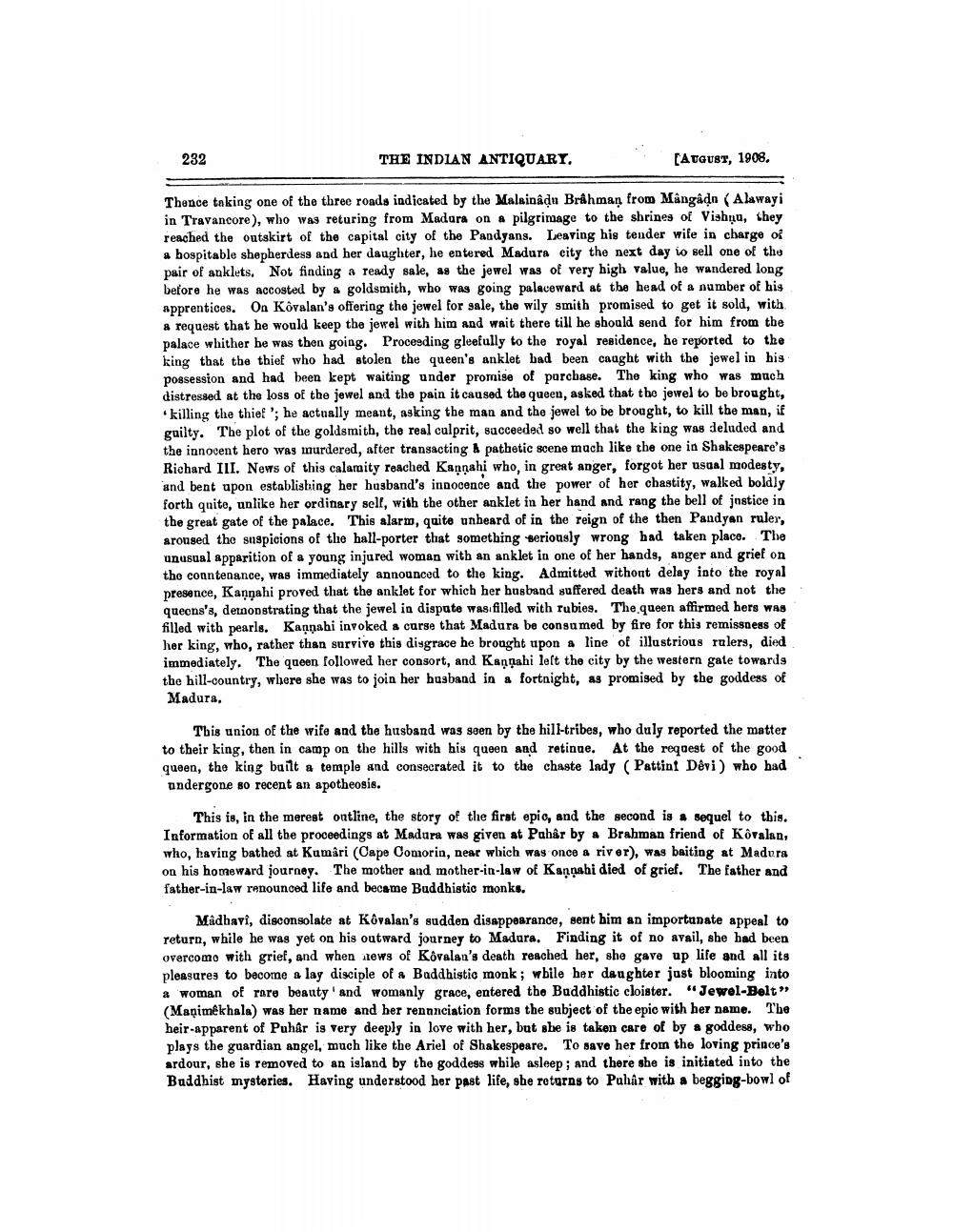________________
THE INDIAN ANTIQUARY.
Thence taking one of the three roads indicated by the Malainâdu Brahman from Mângâḍn (Alawayi in Travancore), who was returing from Madura on a pilgrimage to the shrines of Vishnu, they reached the outskirt of the capital city of the Pandyans. Leaving his tender wife in charge of a hospitable shepherdess and her daughter, he entered Madura city the next day to sell one of the pair of anklets. Not finding a ready sale, as the jewel was of very high value, he wandered long before he was accosted by a goldsmith, who was going palaceward at the head of a number of his apprentices. On Kovalan's offering the jewel for sale, the wily smith promised to get it sold, with a request that he would keep the jewel with him and wait there till he should send for him from the palace whither he was then going. Proceeding gleefully to the royal residence, he reported to the king that the thief who had stolen the queen's anklet had been caught with the jewel in his possession and had been kept waiting under promise of purchase. The king who was much distressed at the loss of the jewel and the pain it caused the queen, asked that the jewel to be brought, 'killing the thief'; he actually meant, asking the man and the jewel to be brought, to kill the man, if guilty. The plot of the goldsmith, the real culprit, succeeded so well that the king was deluded and the innocent hero was murdered, after transacting & pathetic scene much like the one in Shakespeare's Richard III. News of this calamity reached Kannahi who, in great anger, forgot her usual modesty, and bent upon establishing her husband's innocence and the power of her chastity, walked boldly forth quite, unlike her ordinary self, with the other anklet in her hand and rang the bell of justice in the great gate of the palace. This alarm, quite unheard of in the reign of the then Pandyan ruler, aroused the suspicions of the hall-porter that something seriously wrong had taken place. The unusual apparition of a young injured woman with an anklet in one of her hands, anger and grief on the countenance, was immediately announced to the king. Admitted without delay into the royal presence, Kannahi proved that the anklet for which her husband suffered death was hers and not the queens's, demonstrating that the jewel in dispute was filled with rubies. The queen affirmed hers was filled with pearls. Kannahi invoked a curse that Madura be consumed by fire for this remissness of her king, who, rather than survive this disgrace he brought upon a line of illustrious rulers, died immediately. The queen followed her consort, and Kannahi left the city by the western gate towards the hill-country, where she was to join her husband in a fortnight, as promised by the goddess of Madura,
232
[AUGUST, 1908,
This union of the wife and the husband was seen by the hill-tribes, who duly reported the matter to their king, then in camp on the hills with his queen and retinue. At the request of the good queen, the king built a temple and consecrated it to the chaste lady (Pattini Dêvi) who had undergone so recent an apotheosis.
This is, in the merest outline, the story of the first epic, and the second is a sequel to this. Information of all the proceedings at Madura was given at Pahâr by a Brahman friend of Kôvalan, who, having bathed at Kumâri (Cape Comorin, near which was once a river), was baiting at Madura on his homeward journey. The mother and mother-in-law of Kannahi died of grief. The father and father-in-law renounced life and became Buddhistic monks.
Madhavi, disconsolate at Kôvalan's sudden disappearance, sent him an importunate appeal to return, while he was yet on his outward journey to Madura. Finding it of no avail, she had been overcome with grief, and when news of Kôvalan's death reached her, she gave up life and all its pleasures to become a lay disciple of a Baddhistic monk; while her daughter just blooming into a woman of rare beauty' and womanly grace, entered the Buddhistic cloister. "Jewel-Belt" (Manimêkhala) was her name and her rennnciation forms the subject of the epic with her name. The heir-apparent of Puhâr is very deeply in love with her, but she is taken care of by a goddess, who plays the guardian angel, much like the Ariel of Shakespeare. To save her from the loving prince's ardour, she is removed to an island by the goddess while asleep; and there she is initiated into the Buddhist mysteries. Having understood her past life, she returns to Puhâr with a begging-bowl of




